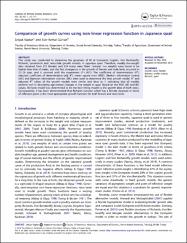| dc.contributor.author | Kaplan, Selçuk | |
| dc.contributor.author | Gürcan, Eser Kemal | |
| dc.date.accessioned | 2022-05-11T14:14:31Z | |
| dc.date.available | 2022-05-11T14:14:31Z | |
| dc.date.issued | 2018 | |
| dc.identifier.issn | 0971-2119 | |
| dc.identifier.issn | 0974-1844 | |
| dc.identifier.uri | https://doi.org/10.1080/09712119.2016.1268965 | |
| dc.identifier.uri | https://hdl.handle.net/20.500.11776/5924 | |
| dc.description.abstract | This study was conducted to determine the goodness of fit of Gompertz, Logistic, Von Bertalanffy, Richards, Levakovich and Janoschek growth models in Japanese quail. Therefore, weekly live-weight data obtained from 372 females and 339 males were fitted. Females' live weights were found to be higher than that of males, and the first divergence in the growth of female and male birds occurred in 21-28 days, and it survived until the experiment (P<.001). The coefficient of determination (R-2), adjusted coefficient of determination (adj. R-2), mean square error (MSE), Akaike's information criteria (AIC) and Bayesian information criterion (BIC) were used to determine the best growth model. R-2 and adjusted R-2 values of the growth models were similar and close to 1, indicating that all models perform well in describing age-related changes in live weight in quail. Based on the MSE, AIC and BIC values, Richards model was determined to be the best fitting model to the growth data of both sexes. Consequently, it has been demonstrated that Richards function which has a flexible structure in terms of inflection point is the most appropriate growth function for both female and male birds. | en_US |
| dc.description.sponsorship | Namik Kemal University, Scientific Research Project UnitNamik Kemal University [NKUBAP.00.23.AR.14.06] | en_US |
| dc.description.sponsorship | This study was supported by Namik Kemal University, Scientific Research Project Unit, NKUBAP.00.23.AR.14.06. | en_US |
| dc.language.iso | eng | en_US |
| dc.publisher | Taylor & Francis Ltd | en_US |
| dc.identifier.doi | 10.1080/09712119.2016.1268965 | |
| dc.rights | info:eu-repo/semantics/openAccess | en_US |
| dc.subject | Growth curve | en_US |
| dc.subject | flexible function | en_US |
| dc.subject | profile analysis | en_US |
| dc.subject | Richards | en_US |
| dc.subject | quail | en_US |
| dc.subject | Multi-Trait Selection | en_US |
| dc.subject | Divergent Selection | en_US |
| dc.subject | Genetic Changes | en_US |
| dc.subject | Body-Weight | en_US |
| dc.subject | Models | en_US |
| dc.subject | Parameters | en_US |
| dc.subject | Describe | en_US |
| dc.subject | Lines | en_US |
| dc.subject | Age | en_US |
| dc.title | Comparison of growth curves using non-linear regression function in Japanese quail | en_US |
| dc.type | article | en_US |
| dc.relation.ispartof | Journal of Applied Animal Research | en_US |
| dc.department | Fakülteler, Veteriner Fakültesi, Zootekni ve Hayvan Besleme Bölümü, Genetik Ana Bilim Dalı | en_US |
| dc.department | Fakülteler, Ziraat Fakültesi, Zootekni Bölümü | en_US |
| dc.authorid | 0000-0003-1101-2296 | |
| dc.authorid | 0000-0002-2394-3795 | |
| dc.identifier.volume | 46 | en_US |
| dc.identifier.issue | 1 | en_US |
| dc.identifier.startpage | 112 | en_US |
| dc.identifier.endpage | 117 | en_US |
| dc.institutionauthor | Kaplan, Selçuk | |
| dc.institutionauthor | Gürcan, Eser Kemal | |
| dc.relation.publicationcategory | Makale - Uluslararası Hakemli Dergi - Kurum Öğretim Elemanı | en_US |
| dc.authorscopusid | 56949758800 | |
| dc.authorscopusid | 36106722600 | |
| dc.authorwosid | Kaplan, Selçuk/ABA-2299-2020 | |
| dc.authorwosid | GURCAN, ESER KEMAL/ABA-4511-2020 | |
| dc.authorwosid | Göçerler, Harun/AAS-2740-2020 | |
| dc.authorwosid | Kaplan, Selçuk/AAA-4359-2022 | |
| dc.identifier.wos | WOS:000416852600001 | en_US |
| dc.identifier.scopus | 2-s2.0-85006944252 | en_US |



















